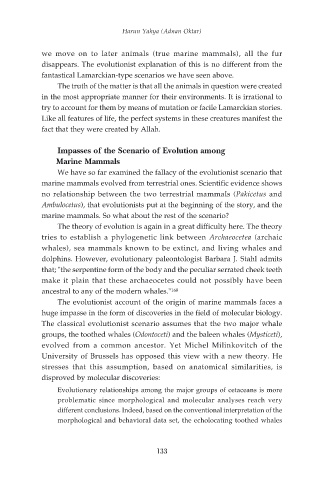Page 135 - Darwinism Refuted
P. 135
Harun Yahya (Adnan Oktar)
we move on to later animals (true marine mammals), all the fur
disappears. The evolutionist explanation of this is no different from the
fantastical Lamarckian-type scenarios we have seen above.
The truth of the matter is that all the animals in question were created
in the most appropriate manner for their environments. It is irrational to
try to account for them by means of mutation or facile Lamarckian stories.
Like all features of life, the perfect systems in these creatures manifest the
fact that they were created by Allah.
Impasses of the Scenario of Evolution among
Marine Mammals
We have so far examined the fallacy of the evolutionist scenario that
marine mammals evolved from terrestrial ones. Scientific evidence shows
no relationship between the two terrestrial mammals (Pakicetus and
Ambulocetus), that evolutionists put at the beginning of the story, and the
marine mammals. So what about the rest of the scenario?
The theory of evolution is again in a great difficulty here. The theory
tries to establish a phylogenetic link between Archaeocetea (archaic
whales), sea mammals known to be extinct, and living whales and
dolphins. However, evolutionary paleontologist Barbara J. Stahl admits
that; "the serpentine form of the body and the peculiar serrated cheek teeth
make it plain that these archaeocetes could not possibly have been
ancestral to any of the modern whales." 168
The evolutionist account of the origin of marine mammals faces a
huge impasse in the form of discoveries in the field of molecular biology.
The classical evolutionist scenario assumes that the two major whale
groups, the toothed whales (Odontoceti) and the baleen whales (Mysticeti),
evolved from a common ancestor. Yet Michel Milinkovitch of the
University of Brussels has opposed this view with a new theory. He
stresses that this assumption, based on anatomical similarities, is
disproved by molecular discoveries:
Evolutionary relationships among the major groups of cetaceans is more
problematic since morphological and molecular analyses reach very
different conclusions. Indeed, based on the conventional interpretation of the
morphological and behavioral data set, the echolocating toothed whales
133

